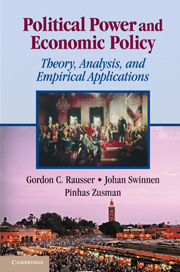Book contents
- Frontmatter
- Contents
- List of Figures
- List of Tables
- Preface
- PART 1 POLITICAL POWER AND ECONOMIC ANALYSIS
- PART 2 IDEOLOGY, PRESCRIPTION, AND POLITICAL POWER COEFFICIENTS
- PART 3 ANALYSIS OF SPECIFIC STRUCTURES
- PART 4 EMPIRICAL APPLICATIONS OF POLITICAL POWER ESTIMATION
- 20 Political Econometrics
- 21 The Political Econometrics of the Israeli Dairy Industry
- 22 Flexible Policy Instruments Given a Political-Power Distribution
- 23 Estimating Statistical Properties of Power Weight Parameters and Their Temporal Shifts
- 24 The Role of Institutions in the Joint Determination of PERTs and PESTs
- References
- Index
23 - Estimating Statistical Properties of Power Weight Parameters and Their Temporal Shifts
Published online by Cambridge University Press: 05 June 2012
- Frontmatter
- Contents
- List of Figures
- List of Tables
- Preface
- PART 1 POLITICAL POWER AND ECONOMIC ANALYSIS
- PART 2 IDEOLOGY, PRESCRIPTION, AND POLITICAL POWER COEFFICIENTS
- PART 3 ANALYSIS OF SPECIFIC STRUCTURES
- PART 4 EMPIRICAL APPLICATIONS OF POLITICAL POWER ESTIMATION
- 20 Political Econometrics
- 21 The Political Econometrics of the Israeli Dairy Industry
- 22 Flexible Policy Instruments Given a Political-Power Distribution
- 23 Estimating Statistical Properties of Power Weight Parameters and Their Temporal Shifts
- 24 The Role of Institutions in the Joint Determination of PERTs and PESTs
- References
- Index
Summary
Introduction
A major criticism of empirical work on reduced form policy governance function analysis is that the stochastic nature of estimated parameters has largely been ignored. The relative power parameters or weights are potentially associated with two sources of stochastic variability, namely, (1) variability arising from transforming policy instruments and economic variables into interest-group objective functions, and (2) variability arising from stochastic events surrounding the political process. Because the unknown parameters are functions of stochastic variables, sampling distributions must accompany point estimates to assess the reliability of estimated parameters and permit hypothesis testing. In early empirical applications, Fulton and Karp (1989) and Nykamp and Somermeyer (1971) consider large sample distributions of estimated power weight parameters. In both cases, estimated variances are based on large sample approximations from only the economic constraints with neither considering stochastic variation arising from the political process. Love et al. (1990) laid out a methodology to generate small sample, bootstrap standard errors for estimated power weight parameters, considering stochastic variation arising only from the constraint structure. In this chapter, we present a bootstrap methodology that integrates stochastic variation in both the economic and political structures. An empirical model of Japanese rice and wheat policy demonstrates the method and conclusions follow.
Empirical Formulation
Given the stochastic variations, we extend the models of Part 1 to recognize that the government can be viewed as maximizing the expected value of a policy governance function that explicates tradeoffs among various political-economic groups concerned with the policy process, subject to an economic possibility set defined by the economy.
- Type
- Chapter
- Information
- Political Power and Economic PolicyTheory, Analysis, and Empirical Applications, pp. 451 - 466Publisher: Cambridge University PressPrint publication year: 2011



